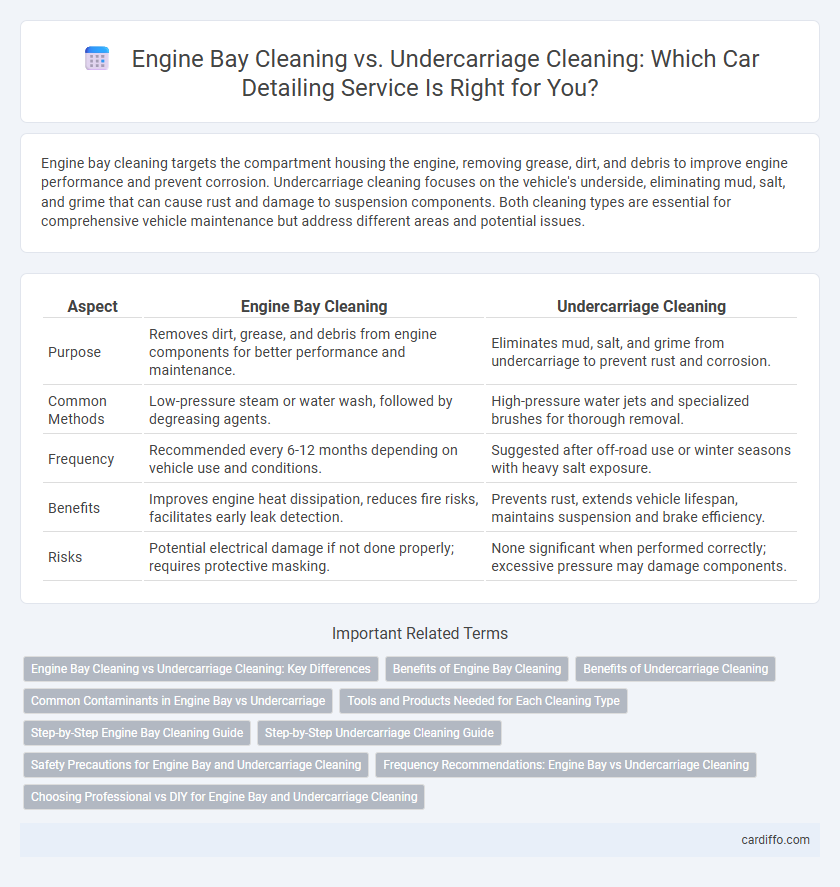Engine bay cleaning targets the compartment housing the engine, removing grease, dirt, and debris to improve engine performance and prevent corrosion. Undercarriage cleaning focuses on the vehicle's underside, eliminating mud, salt, and grime that can cause rust and damage to suspension components. Both cleaning types are essential for comprehensive vehicle maintenance but address different areas and potential issues.
Table of Comparison
| Aspect | Engine Bay Cleaning | Undercarriage Cleaning |
|---|---|---|
| Purpose | Removes dirt, grease, and debris from engine components for better performance and maintenance. | Eliminates mud, salt, and grime from undercarriage to prevent rust and corrosion. |
| Common Methods | Low-pressure steam or water wash, followed by degreasing agents. | High-pressure water jets and specialized brushes for thorough removal. |
| Frequency | Recommended every 6-12 months depending on vehicle use and conditions. | Suggested after off-road use or winter seasons with heavy salt exposure. |
| Benefits | Improves engine heat dissipation, reduces fire risks, facilitates early leak detection. | Prevents rust, extends vehicle lifespan, maintains suspension and brake efficiency. |
| Risks | Potential electrical damage if not done properly; requires protective masking. | None significant when performed correctly; excessive pressure may damage components. |
Engine Bay Cleaning vs Undercarriage Cleaning: Key Differences
Engine bay cleaning targets the compartment housing critical components like the battery, alternator, and air intake, emphasizing the removal of oil, grease, and dirt buildup to enhance engine performance and prevent corrosion. Undercarriage cleaning focuses on the vehicle's underside, addressing accumulated mud, salt, and debris that can cause rust and damage suspension parts. The main difference lies in their specific areas and purposes: engine bay cleaning protects engine functionality, while undercarriage cleaning preserves chassis integrity.
Benefits of Engine Bay Cleaning
Engine bay cleaning improves vehicle performance by removing dirt, grease, and debris that can cause overheating and engine malfunctions. It enhances engine longevity and aids in early detection of leaks or wear, preventing costly repairs. This process also boosts resale value by maintaining a clean, well-cared-for engine compartment.
Benefits of Undercarriage Cleaning
Undercarriage cleaning removes dirt, salt, and road grime that accumulate beneath vehicles, preventing rust and corrosion that compromise structural integrity. Regular cleaning extends the lifespan of suspension components, brake lines, and exhaust systems by reducing wear and corrosion-related damage. It also improves overall vehicle safety by maintaining optimal performance of critical undercarriage parts.
Common Contaminants in Engine Bay vs Undercarriage
Engine bay cleaning commonly targets oil residue, grease, dust, and road salt that accumulate on hoses, wires, and engine components, risking corrosion and impaired performance. Undercarriage cleaning primarily removes mud, salt, grime, and road debris that cling to suspension parts, exhaust systems, and brake components, preventing rust and mechanical wear. Both areas require specialized cleaning products and techniques to effectively dissolve contaminants without damaging sensitive materials.
Tools and Products Needed for Each Cleaning Type
Engine bay cleaning requires specialized degreasers, brushes with stiff bristles, and high-pressure water sprays to effectively remove oil, dirt, and grime from intricate engine components. Undercarriage cleaning involves the use of heavy-duty pressure washers, rust inhibitors, and protective coatings to eliminate road salt, mud, and debris while preventing corrosion. Both cleaning types benefit from microfiber towels and detailing sprays for finishing touches and ensuring optimal cleanliness.
Step-by-Step Engine Bay Cleaning Guide
Engine bay cleaning involves carefully removing dirt, grease, and grime from the engine compartment to maintain optimal engine performance and prevent corrosion. Start by disconnecting the battery, covering sensitive electrical components with plastic bags, then spray a degreaser evenly across the engine bay and let it saturate for 10 minutes. Rinse gently with low-pressure water, use a brush for stubborn areas, dry thoroughly with microfiber towels, and finally reconnect the battery to complete the process.
Step-by-Step Undercarriage Cleaning Guide
Start by safely elevating the vehicle using a jack and jack stands to access the undercarriage thoroughly. Use a high-pressure washer to remove loose dirt and debris, targeting wheel wells, suspension components, and frame areas. Finish by applying a degreaser to stubborn grime, scrubbing with a stiff brush, and rinsing thoroughly to prevent rust and maintain vehicle longevity.
Safety Precautions for Engine Bay and Undercarriage Cleaning
When performing engine bay cleaning, prioritize disconnecting the battery to prevent electrical shorts and cover sensitive components such as the alternator and air intake with plastic bags to avoid water damage. For undercarriage cleaning, ensure the vehicle is securely lifted on stable jack stands and wear protective eyewear to guard against debris and chemical splashes from high-pressure washers or degreasers. Using appropriate cleaning agents designed for automotive parts and following manufacturer guidelines reduces the risk of corrosion and maintains safety during both engine bay and undercarriage cleaning tasks.
Frequency Recommendations: Engine Bay vs Undercarriage Cleaning
Engine bay cleaning is recommended every 12 to 18 months to prevent buildup of grease, dirt, and debris that can affect engine performance and longevity. Undercarriage cleaning should be performed more frequently, approximately every 3 to 6 months, especially in regions with heavy road salt use or off-road driving, to prevent corrosion and damage. Regular maintenance of both areas ensures optimal vehicle function and extends the lifespan of critical components.
Choosing Professional vs DIY for Engine Bay and Undercarriage Cleaning
Professional engine bay cleaning ensures thorough removal of grease, dirt, and corrosion while protecting sensitive electronic components from water damage. DIY undercarriage cleaning can be effective with proper equipment like high-pressure washers but risks incomplete debris removal and potential damage to suspension parts. Choosing professional services guarantees expertise and safety for both engine bay and undercarriage, whereas DIY methods may save cost but require careful technique and knowledge.
Engine Bay Cleaning vs Undercarriage Cleaning Infographic

 cardiffo.com
cardiffo.com